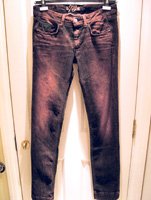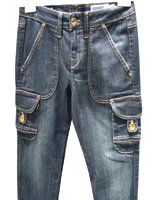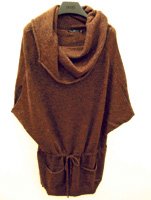Ahead of the Curve
Trend forecaster Denimhead consults on the future of jeans.
When Jill Perilman was a denim designer, she wanted efficient inspiration. She wanted her creativity stimulated, but she also wanted to get out of the office at a reasonable hour.
So in 2004, she founded the service she had always wanted. After years as a designer for Tarrant Apparel Group (which does private label for retailers such as Lane Bryant and Express), Kellwood and Knight Industries, Perilman founded trend-forecasting service Denimhead with the goal of making designers’ lives easier.
Focused on premium denim and casual sportswear, Denimhead produces trend books based on Perilman’s research trips to Europe and Asia. The company launched a Web site, www.denimhead.com, which is doing “phenomenal,” according to Perilman. The site boasts a subscriber base of about 150, while about 700 manufacturers and retailers around the world purchase Perilman’s trend books.
The California Apparel News spoke recently with Perilman—who had just returned from her 10-day biannual trip to Paris, Rome, Amsterdam and London—about key trends for Fall/Winter 2009/2010, as well as the general state of the denim industry.CAN: A designer is supposed to follow her own vision. What are you providing her with? Are you guiding her on the business side rather than the creative side? JP: There are so many details that go into designing denim. We help the designer become inspired just sitting at their desk, not having to go out and look around if they don’t have the time. hellip; It’s also good to know what’s out there so you know how to be different. At your fingertips, you have thousands of examples to look at. The thing I [hear] from most of our clients is about how fast they’re able to get their job done using our service. CAN: Who drives fashion: consumers telling designers what they want or designers telling women what to wear?JP: I think it’s consumers making choices. It’s like when skinny jeans are in: People are going to wear them if they can but not if they can’t wear that kind of jeans. So then the trouser became the big jean because it’s a lot easier for everyone to wear. The “boyfriend” cut is really important right now because it’s a very forgiving fit. The consumer is going to wear the style she’s most comfortable in. But, of course, especially here, celebrities also drive what consumers should be looking at.CAN: How closely do you stay on top of celebrity style?JP: It’s important for me to see what celebrities are wearing, but, for my business, I look past it. Things may be currently popular, but I always have to be thinking about the future, what they’re going to be wearing before they’re wearing it.CAN: What key European trends did you see on your trip?JP: This trip was unusual in that there are two big opposing trends happening: technological and vintage-aged. With technological, the biggest thing there is resin coating; it was seen by all the top denim brands in Europe. Every single brand is now producing amazing resin coating. CAN: What kinds of brands?JP: Replay, Diesel, G-Star, Pepe. Resin coating has been happening for years, but this is the first year they actually look so appealing and are so soft and wearable. They have a sheen that creates sort of a tech look that helps denim compete with the new futuristic looks that are happening. It’s usually done on unprocessed denim, which creates a cleaner look. CAN: How important will this trend be for the U.S. next year?JP: It’s very important for every manufacturer to be working with. The technological trend also includes engineered styling, or jeans that now have engineered leg seaming, knee darts and multi-stitched yokes. It’s a new style for jeans, going forward.
For details, zippers and metal hardware are important, and synthetic fiber blends with denim. CAN: What about the vintage-aged trend?JP: There it’s shredded and mended denim. The most amazing thing I saw on the whole trip was something in this category from Pepe Jeans. They started with a black denim, stripped it down and overdyed it with red. You have a sort of red jean, but it’s very vintage-looking because you can see the black coming through the overdye, which creates a really cool effect. To me, this was just so right on.CAN: On the technological side it sounds like there are things that are new, while the vintage-aged sounds more cyclical. JP: Yes, but that’s what’s so fun about this. It’s the return of really processed denim, which we haven’t seen in the U.S. for four or five years. And it’s really coming back and just looks really new and fun.CAN: What do you mean by “vintage washes”?JP: Whiskers, sanding, grinded edges. CAN: And what about colors?JP: Gray is definitely the color. All Saints, a brand from England, shipped three shades of gray, which I thought was brilliant. It makes the consumer know you believe in that color and also gives them a choice. CAN: What else did you learn on your trip?JP: Knits are so important now. Usually, a big part of my report is what’s going on with denim jackets, but, this season, there weren’t any. Jackets, period, are gone. What’s replacing them are the most amazing knit sweaters and tops. On my trip, I bought about 30 tops, and 29 of them were tunics. So if you’re a denim manufacturer, the bottom of the jeans is now more important than the top because the top’s being covered. So designers need to be aware of that and design around what’s going on with the top part of jeans. I wouldn’t put my money in back pockets but [in] leg details instead. I’m reporting on different ways to create interest in the leg, like buckles, zippers, buttons or lace-ups. CAN: What economic indicators did you see in Europe?JP: The stores were amazingly busy over there. Shopping is not halting at all over there. CAN: You travel a lot to Asia. How much is Asia emerging as a trendsetting market for denim?JP: It’s tremendous. It’s also the most fun trip for me because it’s the most out-there. Most of our clients find the European report more understandable. The report coming out of Tokyo and Hong Kong is a little edgier and extreme but, for me, a lot more fun. We take a lot of pictures of people on the street.
The Japanese are really the leaders for denim. But the L.A., European and Tokyo markets are totally different. CAN: How would you characterize each market?JP: L.A. is very dark premium, a very sophisticated, clean look. Tokyo is fun and obnoxious. Europe has more fashion, more decorated looks, whereas here it’s more clean and vintage-inspired. CAN: Is Asia more important in generating trends than people in the industry give it credit for?JP: Sometimes when things are so extreme people have a hard time seeing them designed at their level. The concept is so extreme they can’t fathom how it would work in their own market. But that’s what we do: We interpret Tokyo trends and how they can be sold in America. CAN: What are these extreme looks you see?JP: The harem-pants look started there years ago, which you’re just starting to see here. Their shapes are not what you would typically see. Their washing ability is also so much more advanced than ours. So their silhouette direction and washing capabilities are more extreme, in a good way, than the rest of the world.
On my European trip, I saw harem pants not just in the stores. There’s one mid-tier harem jean by Bershka, and I can’t tell you how many times I saw it on the street. It’s very cute, and most brands are now offering some form of it. CAN: What is the Los Angeles denim market known for worldwide?JP: Asia looks a lot to our washing. I think our wash techniques are a little more advanced than [those in] the rest of the world. They also look at our marketing. Brands like Seven For All Mankind, True Religion and Citizens of Humanity are all about fit, great denim and great wash. To me that’s the strength of the great brands based in Los Angeles. In Europe and Asia, things are more tricked-up and fashion driven. Here things are more practical.
CAN: You’ve been involved with denim for 18 years. What has it been like the past five, during the explosion of premium denim?JP: It’s hard to keep up with all the brands. It’s interesting how they keep popping up. As far as price points go, I don’t think we’ve seen the limit. And I don’t think there is a limit. If you thought $150 was high at one point, now they’re $250 or $350. And if it’s the right product, consumers will buy it. It will never end. CAN: Is the market over-saturated?JP: If you’ve got a great idea for a new niche jean, do it. Just because it’s saturated doesn’t mean there’s not a great new brand being born today that’s going to surpass everyone else. CAN: But you need to have a great idea. You can’t just put out a $180 jean and be successful. JP: I wouldn’t even waste my time. And if you don’t have the right publicity behind you—you need to have all your ducks in a row. But can it be done? Absolutely.
























